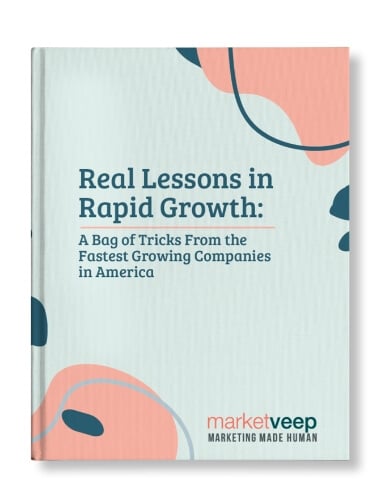Is Your Business Newsletter Making These 9 Common Mistakes?


By Market Veep
Email marketing is tough to do right. Do it wrong, and you’ll end up in the trash or the spam folder. But if you do it right, and employ a smart business newsletter design, you can build a meaningful relationship with your client base. Avoid these 9 common newsletter mistakes to help your business newsletter connect with customers and urge them to continue their relationship with your brand.
Sending business newsletters to your leads and customers is one of the most important email marketing tools at your disposal, but it can also be one of the hardest to get right.
On the one hand, a well-thought-out business newsletter can form a meaningful connection between you and your audience. On the other hand, when done poorly, a newsletter can alienate you from your customers and land you on the fast-track towards the spam folder.
Simply not using email in your content marketing strategy isn’t usually an option - although there are exceptions - so to help you maximize the effectiveness of your company’s newsletter, and ensure you dodge the pitfalls of those who’ve come before you, here’s a list of 9 Common Mistakes You Should Avoid in Your Newsletters:



1) Unnecessary Promotional Material
One of the most common and most disastrous mistakes you can make in your email marketing is an overzealous focus on the promotional material. A newsletter should be a hub of helpful information, links, and tools to benefit your audience, not a billboard advertising why you and your company are so great.
If you want to talk about the achievements your company has earned, then do so in a way that directly ties into how those achievements will benefit the customer experience. Have you recently hired new staff? Delve into how the increased workforce will improve your customer service. Did you just win an award? Use it as further evidence that your product is a valuable commodity to your client.
Promoting yourself is important, and there’s certainly a place for it in your email marketing strategy, but if all you talk about is yourself then you’re missing part of the point.
When in doubt, try organizing your newsletter according to the 80/20 rule, where 80% of your content is helpful and educational, and only 20% is specifically about your business and the services it offers. Some marketers will even say to use a 90/10 formula, so feel free to be flexible with your approach and pay attention to what strategies seem to best connect with your readership.
2) Covering Too Many Topics
Another common pitfall of email newsletters is a lack of focus. If your newsletter looks like a smörgåsbord of vaguely connected elements, you probably need to spend some time rethinking your approach.
You want your newsletters, like all of your inbound marketing content, to have a clear and defined goal. Find out what kinds of content your readers value and strive to give them more of that in each and every newsletter you send out.
3) Trying to Appeal to Everyone
Not everyone will be a fan of your content, and that’s okay. Not everyone who gives you their contact information will end up being a qualified lead, and pinpointing qualified leads is an important part of email marketing.
Instead of focusing on the people who unsubscribe, focus on the people who hang around. How often do they read their email? What types of links do they usually click? Gather information and then design a newsletter strategy around your reader’s preferences. Of course, if you’re getting a disproportionate amount of unsubscribes, then you may need to reexamine what you're putting in your emails.
Segmenting your audience list can be a great way to send more effective email newsletters. Take a look at your buyer personas and design content that targets their interests and the topics they gravitate towards. This may mean setting up a few variations of your newsletter for each of the buyer personas you’re marketing to, but it can dramatically increase audience engagement and keep your newsletters from ending up in the trash.
4) Going Off-Brand
While it can be tempting to include content in your newsletter just for attention, if it’s not directly relevant to your brand, don’t do it. Content that doesn’t mesh with your established brand is often distracting and can show a lack of confidence or clarity in your brand’s identity that will hinder your readers’ engagement.
If you want to include a fun comic or meme, feel free to do so! Your newsletters don’t have to be all-business-all-the-time. But they do need to be consistent, so if you include something “different,” make sure it’s still applicable to your brand.
5) Sending From an @noreply
Your newsletter should be an avenue of communication between you and your client base, but when you send your newsletters out via an @noreply or @donotreply, you actively inhibit the very communication you should be encouraging.
Thankfully, avoiding this is easy. Choose someone within your company to be the “face” of your newsletters, and have their name be behind each one. When people receive an email from someone they can identify as a real person, they’re more likely to open the email and engage with the content contained within. The more personalized your newsletters feel the more genuine your company will come across.
6) Using Boring Subject Lines
When drafting a newsletter, you want to use a subject line that employs the same tools your blog posts do in their titles. A good subject should entice the reader and promise them content that they’ll find helpful, encouraging, or educational.
A boring subject like “September Newsletter” won’t attract much attention, but something specific to your buyer personas will. If you want to categorize your newsletter by including the month, you can do that, but you’ll need to add something more to it so the reader gets an idea of what kind of content is actually in the newsletter.
If you need some inspiration, take a look at these examples from one of HubSpot’s blog posts that shows off some of the best email subject lines they’ve come across:
- "*Don't Open This Email*" (via Manicube)
- "What Did You Think? Write a Review." (via REI)
- "Best of Groupon: The Deals That Make Us Proud (Unlike Our Nephew, Steve)" (via Groupon)
- "Where to Drink Beer Right Now" (via Eater Boston)
- "👗 Free (Cool!) Clothes Alert 👖" (via Clover)
- "The timer’s going off on your cart!" (via King Arthur Flour)
Each of these examples is appealing to something specific in their audience. Manicube uses playful reverse psychology; REI asks an honest question; Groupon uses surprising humor; Eater Boston takes advantage of a timely, tailored message; Clover uses fun emojis to catch the eye; and King Arthur Flour uses relevant urgency to motivate the reader to action.
Each of these examples shows an understanding of the intended target audience that’s important to take to heart when writing a subject line for your newsletter. Study your buyer personas, track what links they click on and what kinds of content seem to speak to them, and then personalize your subject lines to not only appeal to your audience's unique sensibilities but to also delight them with clever, thoughtful surprises.
On a similar note, never ignore the preheaders either. An empty preheader will do little to attract readers, and simply repeating your subject title reeks of laziness. You want your preheader to reinforce the subject title and set a clear expectation for what the newsletter will contain.
7) Boring Images
Images reinforce written content, draw the reader’s eye, and when used well, build excitement and engagement. This is true for your blog posts and eBooks, and it remains true for your newsletters.
Whenever possible, be specific with your images and curate them to match the tone and content of the newsletter in as many ways as possible. If you don’t have access to professional photography, stock images can be a reliable fallback option. Be careful though, because stock images are easy to spot. When they’re poorly chosen, they can hinder your audience’s willingness to connect with you and your content.
8) Forgetting to Optimize for Mobile
With a growing majority of people relying on their phones for email, neglecting to optimize your business newsletters for mobile devices is one of the worst mistakes you can make.
If your newsletter looks bad in a mobile email app, it’ll be quickly discarded. If your images don’t render for mobile, you’ll face the same outcome. To combat this, reduce the size of your images, use short blocks of text rather than large ones, and always add alt-text to your email images.
You want your newsletter to be easy to read regardless of the outlet your readers choose to view it on, so do the work to properly optimize your emails for desktops and phones, and test the user experience for quality control.
9) Lack of “Helpful” Content
Ultimately, every piece of content you put out should serve your customer in some way. If you’re sending customers emails that don’t offer helpful, valuable content, they’ll unsubscribe and you’ll lose out on a valuable source of communication.
A good newsletter invites readers to engage with friendly, helpful advice that will help them solve their problems. You’ll want to include links to your website, ways for the reader to get in touch with you, and while some call-to-actions (CTAs) can be good, make sure they direct the reader to more information, not a sales pitch.
If your readership doesn’t find your newsletter helpful to them personally, you’ll lose their attention, so make sure everything you put into your email newsletters serves to better their lives and lead them towards solutions.
Get The Latest From
Market Veep
RELATED ARTICLES

Master Sales Funnel Strategies: Tofu Mofu Bofu!
Between SEO, SEM, and SERPS, we’re always finding clever ways to break down concepts into four...

Why B2B Demand Generation Strategies Work
The sparkly, PR rep cousin of lead generation, this approach is all about growing your audience by...

Key Marketing Strategies for Robotics Manufacturers
In fact, experts project that the U.S. Robotics market is on track to pull in $7.85 billion in 2024...

Get Growing!
Download our eBook and get advice from 8 CEOs of Inc. 5000 companies in their own words.

GREAT MARKETING PARTNER
Market Veep is a great firm that handles all of our marketing efforts. This is the second time that I have used the firm. I highly recommend Market Veep!

Cres F.

EXCEPTIONAL EXPERIENCE
Market Veep's Onboarding Experts in Inbound Marketing are an absolute game-changer! From the get-go, their approach was top-notch. Market Veep's team has undoubtedly set the bar high for excellence in inbound marketing. Five stars aren't enough to commend their outstanding service!

Matthew W.

BEST PARTNER EVER!
As a growing business, setting up our first-ever HubSpot account was a crucial step towards enhancing our marketing and customer management strategies. From the moment we contacted MarketVeep, their team demonstrated professionalism, expertise, and a genuine desire to help us succeed. Overall, our experience with MarketVeep was exceptional, and we couldn't be happier with the results. Thanks to their guidance, we are now utilizing HubSpot to its fullest potential, streamlining our marketing efforts, and nurturing leads more effectively.

Jean M.

SET UP FOR SUCCESS!
We had an exceptional experience with Market Veep! Their team is professional, super organized, and friendly, and I truly enjoyed working with them. They executed on time and made the process super easy with their organization and documentation. In addition, they provided additional guidance and answered my many questions as I was new to HubSpot, and provided documentation resources for future use. We're now set up to leverage all that HubSpot marketing has to offer, and we couldn't have done it without Market Veep's expertise.

Bailey G.

OUTSTANDING WORK
There aren't enough words to describe the outstanding, professional work MarketVeep has provided to our company. From start to finish, the website design/development team at MarketVeep assigned to our project was extremely knowledgable, respectful, efficient and timely. The results went above and beyond our expectations and we could not be more thrilled with the improvements to the user experience on our website! Bravo MarketVeep, we'll absolutely be back with more projects!

Nadine B.

5 STARS FOR MARKET VEEP!
We had a fantastic experience with Market Veep! Their expert team seamlessly guided us through implementing HubSpot and provided comprehensive training across Sales, Service, and Marketing Hubs. Their knowledge and support significantly enhanced our workflow and overall efficiency. Highly recommend Market Veep for top-notch HubSpot solutions!

Anneke C.







